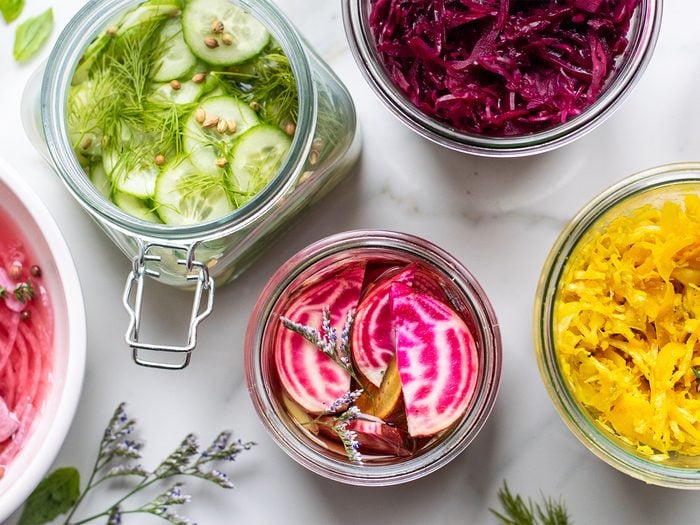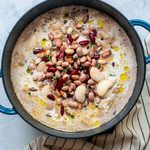A Beginner’s Guide to Making Fermented Foods

The benefits of fermented foods and an easy way to make them at home
It’s hard for me to remember a food life before pickles. They’re a staple in my fridge and they make their way on top of many of my meals, adding a sweet-sour bite that elevates everyday foods like eggs and toast. While a full-on canning process is not for the faint of heart (or for those with limited storage space), a quicker fermentation method allows food to be preserved in small batches and provides more health benefits than your standard dill pickle.
(Related: 7 Common Probiotic Mistakes You’re Making)
So what happens when you pickle something? There are two distinct methods you can use. The first, called chemical pickling, occurs when you immerse food in a brine usually made of vinegar, salt and sugar. This method creates an acidic environment where bacteria can’t grow, and it’s what turns cucumbers into the pickles you find in jars at the grocery store. But while delicious, these pickles don’t produce the same kind of gut-friendly bacteria that the second method, fermentation, does.
What’s fermentation, anyway?
Fermentation occurs when the sugars in food react with naturally present bacteria to produce lactic acid. The longer the food sits, the more lactic acid it produces and the tangier—and better preserved—it will get. Just think of ferment as the brined pickle’s funkier cousin.
And it’s that lactic acid that gives fermentation its primary health benefit. Lactic acid bacteria is similar to the strains found in fermented dairy products, like yogurt and kefir, and boasts the same benefits to the gut microbiome. Some strains of lactic acid bacteria act as probiotics to promote a healthy gut environment and improve the nutritional value of the food you eat. Lactic acid bacteria produces enzymes that aid in the breakdown of nutrients found in hard-to-digest foods like fibre and lactose, and can even enhance the absorption of vitamins and minerals.
On top of facilitating a healthy gut microbiome, bacteria from fermentation has been shown to have positive effects on immunity, creating a hostile environment in the gut for harmful bacteria that can cause infection. Lactic acid can also lower cholesterol levels and improve blood sugar control, leading to better heart health.
How to Start Pickling
To reap those nutritional benefits, you’ll need to ensure your ferments are successful—and that means controlling their environment. Salt and acid are the nemesis of bad bacteria, and by using both of these ingredients, along with proper storage conditions, you can create a habitat where friendly lactic acid bacteria thrives and fermented foods stay crisp and tangy.
In order prevent the growth of harmful bacteria, keep your hands, work space and any storage vessels squeaky clean. Once you add salt and water, you’ll need something to weigh down the vegetables, keeping them submerged and limiting their exposure to oxygen. My go-to method is using a small Ziploc bag filled with water, which can easily be moulded to the shape of the container you’re using.
Fermentation takes anywhere from a few days to a few months, depending on the food and the flavour you’re after. Foods with more natural sugar, like fruit, will ferment more quickly, so try them after a day or two to see how the flavour is developing; they should be crisp, sour and slightly sweet. Typically, you can allow vegetable pickles, like cucumbers and cabbage, to ferment at room temperature for about five days before transferring to the refrigerator. In the fridge, the cooler temperature will slow down the fermentation process, but the flavour will continue to intensify. Then they can be stored for up to one month.
Start with Sauerkraut
A good fermentation gateway is sauerkraut, which can be made with just two simple ingredients—sliced cabbage and salt—and is great in sandwiches, served with sausages or added to grain bowls for a salty crunch. Speaking of salt, standard table salt is not the best choice here, since it contains additives that can leave a chemical taste and prevent the growth of good bacteria. Instead, go with kosher or pickling salt for the best results. When making your sauerkraut, massage the salt into the cabbage—that will help it release water, creating its own brine. For firmer vegetables with a lower water content, like carrots and beets, you may need to help the process by adding some water along with the salt to ensure everything is submerged.
Once you have your basic recipe down, get creative with flavour combinations by adding whole or ground spices, like peppercorns, coriander, turmeric, freshly grated ginger or a sprinkle of chili flakes for extra heat. Then swap in any of the vegetables lingering in your crisper drawer, transforming them into crunchy, colourful ferments packed with health benefits. Your gut and your tastebuds will thank you.
Next: A Simple Recipe for Beet Sauerkraut That’s Good for Your Gut




